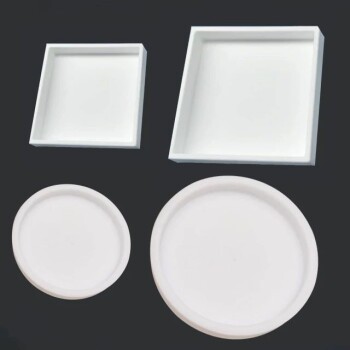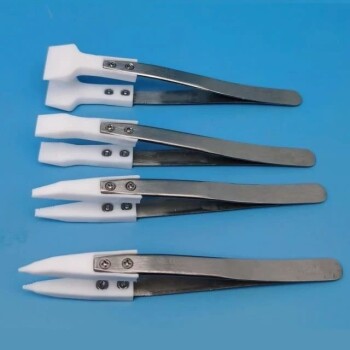In one of the most famous accidents in materials science, Polytetrafluoroethylene (PTFE) was discovered on April 6, 1938, by Dr. Roy J. Plunkett, a chemist working for Kinetic Chemicals. He was attempting to create a new, non-toxic refrigerant, not a novel polymer. The resulting substance was patented in 1941 and later trademarked as Teflon in 1945.
The discovery of PTFE is a classic case of scientific serendipity. A failed experiment with refrigerant gas unexpectedly produced a material with such an extraordinary combination of properties—chemical inertness, thermal stability, and low friction—that it created entire new categories of industrial and consumer applications.
The Story of the Accidental Discovery
The creation of PTFE was not the result of a targeted research goal. It was the product of a curious mind investigating an unexpected failure.
The Intended Goal: A New Refrigerant
Dr. Plunkett was tasked with developing a new chlorofluorocarbon (CFC) refrigerant. His work involved synthesizing large quantities of tetrafluoroethylene (TFE) gas and storing it in pressurized metal cylinders for later use.
The Anomaly in the Cylinder
On the morning of April 6, 1938, Plunkett and his assistant checked a cylinder of TFE gas that had been frozen and compressed. Although the cylinder's weight indicated it was still full, no gas came out when the valve was opened.
A Moment of Curiosity
Instead of discarding the apparently faulty cylinder, Plunkett's curiosity took over. He insisted on investigating the anomaly, eventually sawing the metal cylinder in half.
The Unveiling of a New Substance
Inside, he did not find TFE gas. Instead, he found a waxy, white, and exceptionally slippery solid powder. The TFE gas had spontaneously polymerized into what we now know as PTFE, with the iron from the container's interior likely acting as a catalyst for the reaction.
Why This Accident Mattered: PTFE's Unique Properties
Plunkett immediately recognized that this accidental substance was unusual. Subsequent testing revealed a profile of characteristics that was, at the time, unprecedented in a single material.
Unmatched Chemical Inertness
PTFE is resistant to nearly all corrosive chemicals, acids, and solvents. This makes it an ideal lining for pipes, valves, and vessels in harsh chemical processing environments.
Extreme Thermal Stability
The material maintains its properties across an incredibly wide range of temperatures. It can withstand extreme cold and continuous service temperatures up to 260°C (500°F).
The Lowest Coefficient of Friction
Known as one of the most slippery solid materials in existence, PTFE has an extremely low coefficient of friction. This property is the basis for its use in non-stick coatings and low-friction bearings.
Superior Electrical Insulation
PTFE is an outstanding electrical insulator with high dielectric strength and a low dissipation factor. This makes it invaluable for high-frequency applications, such as in coaxial cables and circuit boards.
Understanding the Trade-offs
Despite its remarkable properties, PTFE is not a perfect material for every application. Understanding its limitations is critical for proper engineering and design.
Low Mechanical Strength
PTFE is a relatively soft material. It has low tensile strength and is susceptible to "creep," or deformation under a sustained load. It is often reinforced with fillers like glass or carbon to improve its mechanical stability.
Processing and Bonding Challenges
Because of its chemical inertness and high melt viscosity, PTFE is very difficult to process using conventional techniques like injection molding. It is also famously difficult to bond to other surfaces without specialized primers or surface treatments like chemical etching.
Relatively High Cost
Compared to commodity plastics like polyethylene or polypropylene, PTFE is significantly more expensive. Its use is therefore typically reserved for applications where its unique properties are a critical requirement.
Making the Right Choice for Your Goal
The story of PTFE's discovery offers more than just historical trivia; it provides valuable lessons for modern innovators and engineers.
- If your primary focus is innovation: Recognize that investigating unexpected anomalies, rather than dismissing them as failures, can lead to the most significant breakthroughs.
- If your primary focus is material selection: Understand that a material's value comes from its unique combination of properties, not just one standout feature.
- If your primary focus is product design: Remember that even a "miracle" material has practical limitations and trade-offs that must be understood and managed.
The discovery of PTFE remains a powerful reminder that progress is often born from curiosity in the face of the unexpected.
Summary Table:
| Event | Date | Key Figure | Outcome |
|---|---|---|---|
| Discovery | April 6, 1938 | Dr. Roy J. Plunkett | Accidental polymerization of TFE gas into PTFE |
| Patent Filed | 1941 | Kinetic Chemicals | Protection for the novel polymer |
| Trademark Registered | 1945 | DuPont (successor to Kinetic) | PTFE branded as 'Teflon' |
Leverage the Legacy of PTFE with KINTEK
The accidental discovery of PTFE revolutionized materials science. Today, KINTEK carries that legacy forward by manufacturing precision PTFE components—including seals, liners, and custom labware—that harness PTFE's legendary chemical inertness, thermal stability, and low friction for your most demanding applications.
Whether you're in the semiconductor, medical, laboratory, or industrial sector, we provide:
- Custom Fabrication: From initial prototypes to high-volume production runs.
- Precision Production: Ensuring the highest quality and performance for your critical processes.
- Expert Material Selection: Helping you navigate the trade-offs to select the right PTFE solution for your design goals.
Ready to incorporate the unique properties of PTFE into your next project? Contact our experts today to discuss your specific needs and how our custom PTFE solutions can drive your innovation.
Related Products
- Custom PTFE Parts Manufacturer for Teflon Containers and Components
- Custom PTFE Parts Manufacturer for Teflon Parts and PTFE Tweezers
- Custom PTFE Square Trays for Industrial and Laboratory Use
- Custom PTFE Volumetric Flasks for Advanced Scientific and Industrial Use
- Custom PTFE Bottles for Diverse Industrial Applications
People Also Ask
- What are some additional physical properties of PTFE? Beyond Non-Stick: Discover PTFE's Elite Thermal & Chemical Resistance
- How is PTFE used in industrial processes? Maximize Safety and Efficiency
- How is PTFE processed into usable shapes? From Powder to Precision Parts
- How does PTFE's coefficient of friction compare to other materials? Discover the Slipperiest Solid
- Is PTFE toxic to humans? The Critical Role of Temperature in PTFE Safety


















